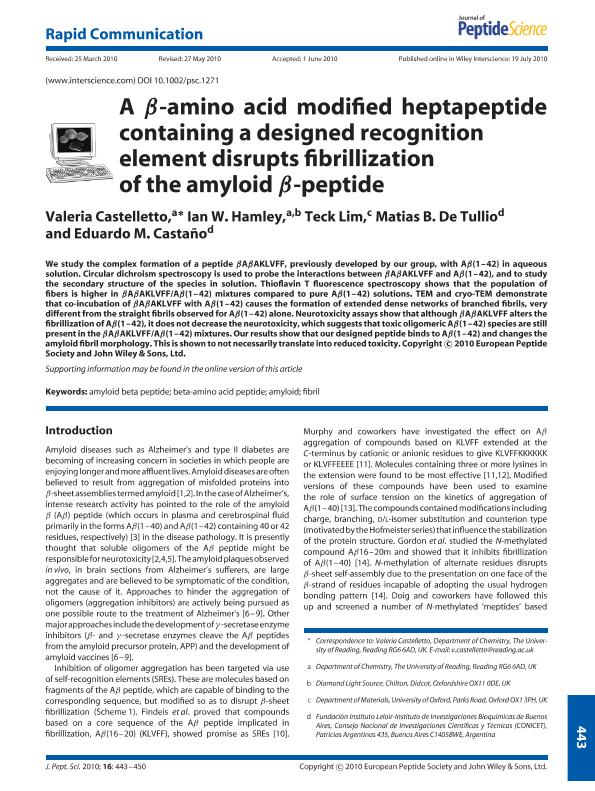Artículo
A β-amino acid modified heptapeptide containing a designed recognition element disrupts fibrillization of the amyloid β-peptide
Fecha de publicación:
09/2010
Editorial:
Wiley
Revista:
Journal Of Peptide Science
ISSN:
1075-2617
Idioma:
Inglés
Tipo de recurso:
Artículo publicado
Clasificación temática:
Resumen
We study the complex formation of a peptide betaAbetaAKLVFF, previously developed by our group, with Abeta(1-42) in aqueous solution. Circular dichroism spectroscopy is used to probe the interactions between betaAbetaAKLVFF and Abeta(1-42), and to study the secondary structure of the species in solution. Thioflavin T fluorescence spectroscopy shows that the population of fibers is higher in betaAbetaAKLVFF/Abeta(1-42) mixtures compared to pure Abeta(1-42) solutions. TEM and cryo-TEM demonstrate that co-incubation of betaAbetaAKLVFF with Abeta(1-42) causes the formation of extended dense networks of branched fibrils, very different from the straight fibrils observed for Abeta(1-42) alone. Neurotoxicity assays show that although betaAbetaAKLVFF alters the fibrillization of Abeta(1-42), it does not decrease the neurotoxicity, which suggests that toxic oligomeric Abeta(1-42) species are still present in the betaAbetaAKLVFF/Abeta(1-42) mixtures. Our results show that our designed peptide binds to Abeta(1-42) and changes the amyloid fibril morphology. This is shown to not necessarily translate into reduced toxicity.
Palabras clave:
Peptido Amiloide
,
Neurotoxisidad
,
Enfermedad Alzheimer
,
Modelo Celular
Archivos asociados
Licencia
Identificadores
Colecciones
Articulos(IIBBA)
Articulos de INST.DE INVEST.BIOQUIMICAS DE BS.AS(I)
Articulos de INST.DE INVEST.BIOQUIMICAS DE BS.AS(I)
Citación
Castelletto, Valeria; Hamley, Iam W.; Lim, Teck; de Tullio, Matias Blas; Castaño, Eduardo Miguel; A β-amino acid modified heptapeptide containing a designed recognition element disrupts fibrillization of the amyloid β-peptide; Wiley; Journal Of Peptide Science; 16; 9; 9-2010; 443-450
Compartir




